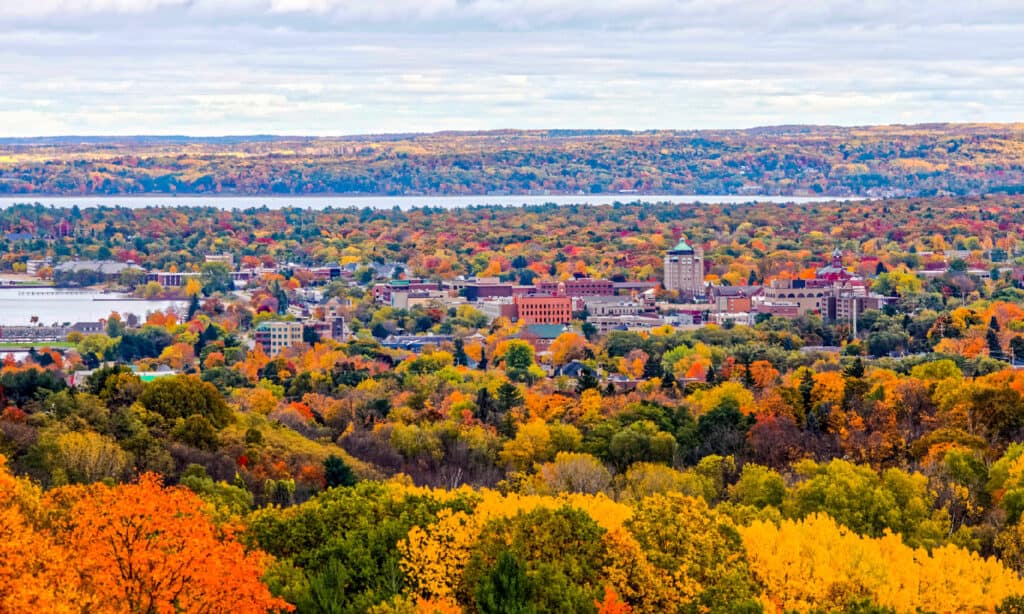If you want to explore the natural beauty that the state of Michigan offers, you should know that there is a lot to see. You can see not only the beautiful shores of Lake Michigan but also many streams, rivers, and waterfalls. There are also forests and breathtaking sand dunes.
There are many fantastic biking trails in the state of Michigan. In fact, there are 2,478 miles of rail trails. Read on to learn about the longest biking trail in Michigan!
The Longest Biking Trail in Michigan

The Fred Meijer White Pine Trail is the longest biking trail in Michigan, stretching for 92.6 miles.
©iStock.com/garyrennis
The longest biking trail in Michigan is the Fred Meijer White Pine Trail. Although the Iron Belle Trail is technically longer and connects to a network spanning over 2,000 miles of trails, it is not developed or well-defined at this point. Because of this, the title still goes to the Fred Meijer White Pine Trail. The trail goes for 92.6 miles, and it traverses a variety of settings.
If you ride your bike along this trail, you can see busy towns, farmlands, and forests. It starts in the northern part of Lower Michigan and goes all the way to Cadillac. There are many rest stops, lodging options, camping options, and food services along the way.
The Fred Meijer White Pine Trail Route
The Fred Meijer White Pine Trail isn’t officially divided into sections. However, there are a few logical points at which we can divide the trail:
- North of Grand Rapids to Sand Lake: The trail starts close to the stadium for the West Michigan Whitecaps Minor League Baseball Team, which is just north of Grand Rapids. You start by heading north and getting to Rockford after a little bit over eight miles from the start of the trail. Then, you’ll pass through Cedar Springs. The paved portion of the trail will end as you approach Sand Lake, which is about 12 miles north of Rockford.
- Sand Lake to Big Rapids: Once you leave Sand Lake, it will be about 7 miles to Howard City. Then, after another 9 miles, you’ll get to Big Rapids. You can head into town using the Big Rapids Riverwalk. Once you leave this portion of the trail, there is a 319-foot bridge that allows you to cross the Muskegon River with a lovely view.
- Big Rapids to Reed City: After you cross the Muskegon River, Paris lies about six miles north. You can take the trail through Paris Park, where you can go canoeing, camping, and fishing. Heading north another 6.4 miles, you’ll get to Reed City. Here, you can take a covered bridge over the Hersey River.
- Reed City to Lake Cadillac: At Reed City, you will cross a junction with Pere Marquette Rail-Trail; the trails intersect at a reconstructed replica of the historic downtown railroad depot of Reed City. Then, you’ll go another 17 miles to Tustin. Here, you can stop at the Pine River Museum and look at fascinating railroad memorabilia. Go another 11.2 miles north, and you’ll get to the end of the trail at Lake Cadillac.
Planning for a Tour of Michigan’s Longest Biking Trail

The Fred Meijer White Pine Trail is accessible from many communities along the trail.
©iStock.com/lzf
You can gain access to this trail at every community along the trail. Additionally, your plans for your journey should take into consideration whether you want to complete the entire trip in one day or split it up into two or more days.
If you want to do the latter, there are plenty of campsites available along the trail. In this case, you would want to bring the necessary overnight camping equipment.
Be aware of what the weather is going to be like before you travel. Inclement weather could make the ride more difficult. There are parts of the trail that remain unpaved, such as the 29 miles between Sand Lake and Big Rapids.
You will be riding on asphalt in the paved sections, which will be relatively smooth. However, you may be riding on gravel, ballast, and crushed stone in other parts.
Navigating the Route
Whether or not the trail is well-maintained often depends on sheer luck. Because public funding for state parks in Michigan has been reduced, the upkeep of the trail depends quite a bit on volunteers. A lot of this work is organized by Friends of the White Pine Trail.
There are many communities along the route. It helps to be aware of the order in which you will go through these towns. It would also be beneficial to have a map to help you get your bearings. You can find online maps on the state park website.
The Fred Meijer White Pine Trail Difficulty
The Fred Meijer White Pine Trail is considered to be somewhat difficult overall. This is simply because it is so long and has such varied riding surfaces. In the areas where the trail is not paved, you will likely have to bike through quite a bit of gravel and debris. This can be quite rough for inexperienced cyclists.
Because the upkeep of the trail is not always immaculate, even the paved portions can be somewhat rough. If you are a novice cyclist, you may want to attempt to ride along one portion of the trail rather than planning to traverse the entire course on your first try.
Where is the Fred Meijer White Pine Trail Located on a Map?
The Fred Meijer White Pine Trail is a 92-trail on the west side of Michigan, located near Comstock, that begins on the north side of Grand Rapids and ends in Cadillac. It passes through the counties of Kent, Mecosta, Montcalm, Osceola, and Wexford.
Wildlife on the Longest Biking Trail in Michigan

The Fred Meijer White Pine Trail is a great place to see many native plants and animals in the temperate climate of Michigan.
©iStock.com/Pavel1964
Michigan has a temperate climate that is friendly to many plants and animals. When you are biking on the Fred Meijer White Pine Trail, you will likely see many flora and fauna thriving in their natural environment.
You may see black bears when you ride through the forested areas. If you see them, try to stay away. Generally, they don’t go out of their way to come after humans. However, they will defend themselves against people they perceive to have come too close. There are also many white-tailed deer throughout these forests.
In addition to this, you may see moose, bobcats, and eastern gray wolves. There are more than 200 species of birds in these forests as well, including the bald eagle and sandhill crane.
The photo featured at the top of this post is © iStock.com/pat138241
Thank you for reading! Have some feedback for us? Contact the AZ Animals editorial team.






